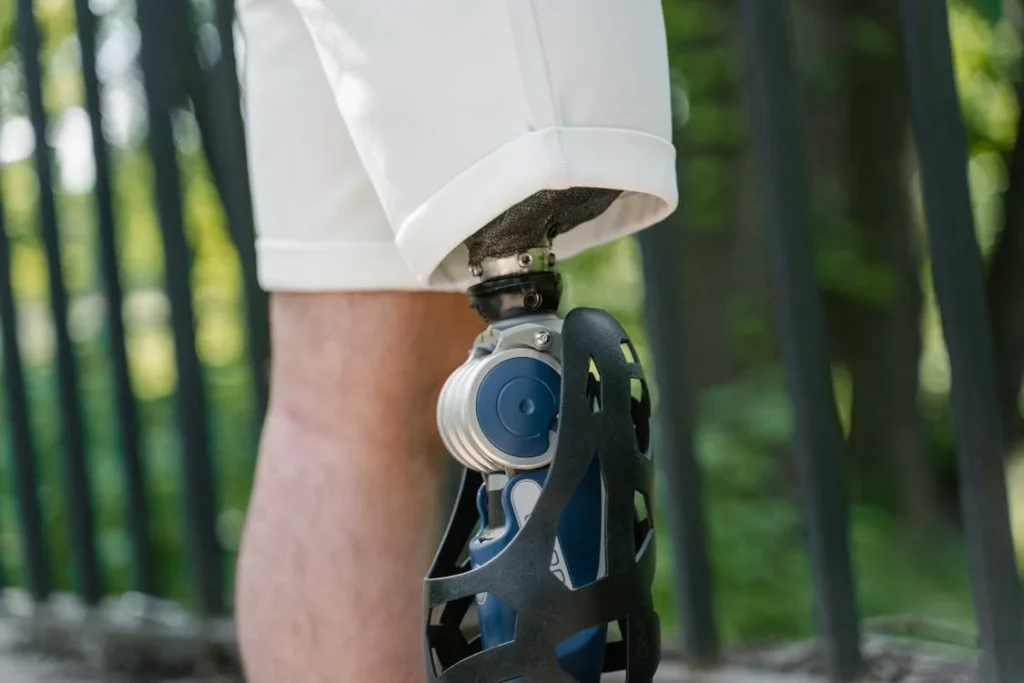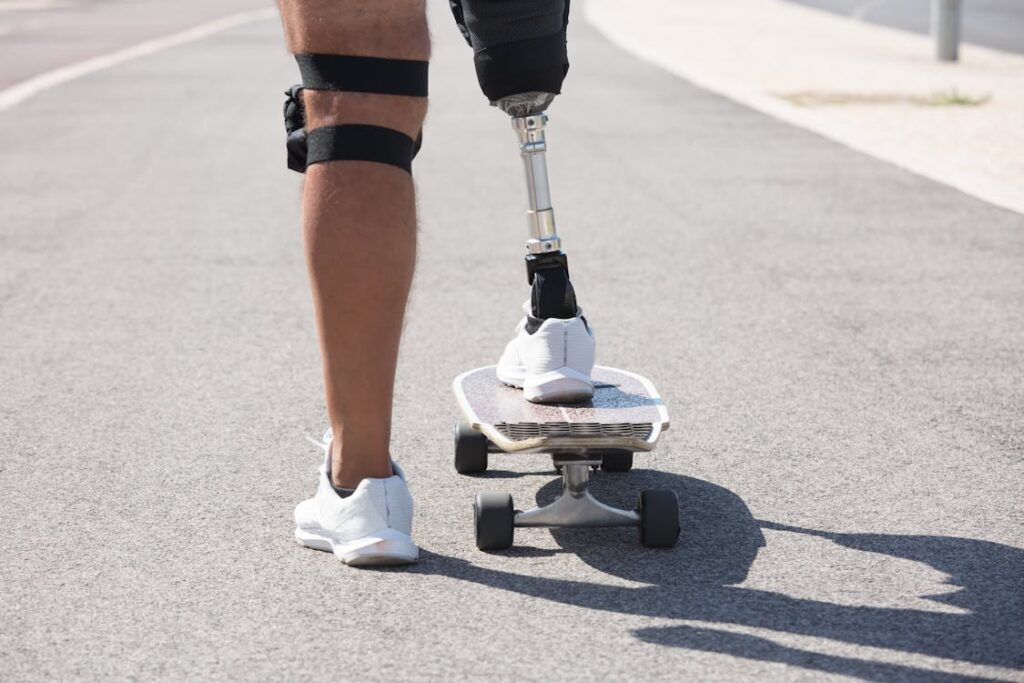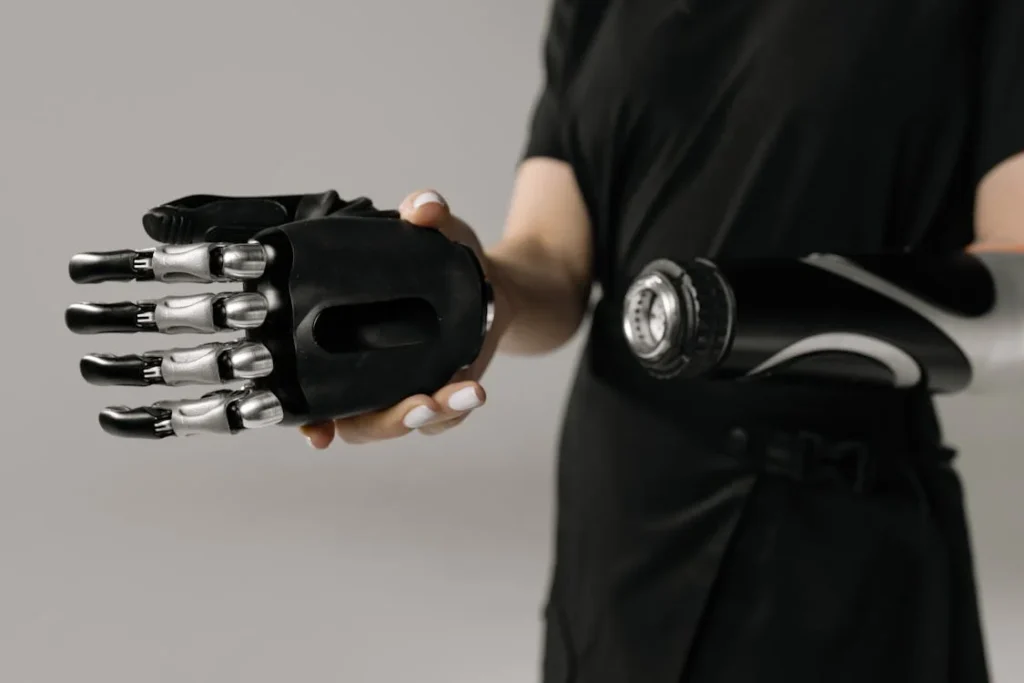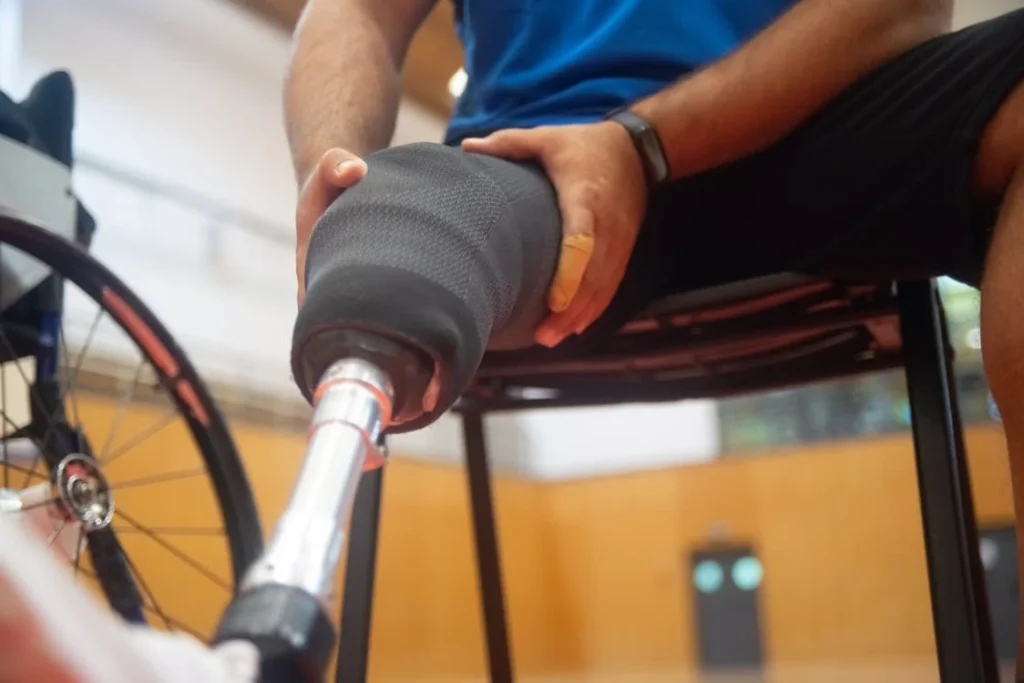Prosthetic devices are life-changing innovations that restore independence, mobility, and confidence. Whether you rely on a prosthetic hand, leg, or another device, it becomes an essential part of your daily routine. However, regular use naturally exposes prosthetics to wear and tear, which can affect their functionality and comfort over time.
Preventing wear and tear is about more than preserving the device—it’s about maintaining your quality of life. With a few proactive habits and care techniques, you can extend the life of your prosthetic and ensure it continues to serve you well. In this guide, we’ll explore practical, actionable strategies to help you protect your prosthetic from damage and maximize its durability.

Understanding the Causes of Wear and Tear
Wear and tear on prosthetic devices is a natural consequence of everyday use. However, understanding the common causes can help you take targeted steps to minimize damage.
The most frequent culprits include repetitive stress, environmental exposure, improper handling, and neglect of routine maintenance.
Everyday activities like walking, lifting, or gripping can exert stress on joints, sockets, and liners. Over time, this stress can loosen screws, weaken adhesives, or cause material fatigue.
Environmental factors such as humidity, heat, dirt, and water exposure can also degrade materials like silicone, carbon fiber, or plastic.
Improper handling, like dropping the device or using it for tasks it wasn’t designed for, can accelerate damage. Finally, neglecting regular cleaning and maintenance allows dirt and bacteria to accumulate, which can weaken components and affect performance.
By identifying these risk factors, you can take steps to protect your prosthetic and prevent unnecessary damage.
Establishing a Daily Care Routine
One of the most effective ways to prevent wear and tear is to incorporate a consistent daily care routine. Start by cleaning your prosthetic at the end of each day.
Use a mild soap and warm water to gently remove dirt, sweat, and oils. Pay special attention to high-contact areas like the socket or liner, which are more likely to accumulate grime.
Once cleaned, ensure your prosthetic is completely dry before storing or reassembling it. Moisture can weaken materials and create an environment for bacterial growth, so air-drying or patting with a lint-free cloth is essential.
Inspect your prosthetic during cleaning. Look for signs of wear such as cracks, loose components, or discoloration. Identifying potential issues early allows you to address them before they become more significant problems.
For businesses like clinics, promoting daily care routines to users can reduce the frequency of repair requests and enhance the overall longevity of the prosthetics you provide. Educational resources, such as brochures or instructional videos, can help users establish these habits.
Handling Your Prosthetic with Care
How you handle your prosthetic device can significantly impact its lifespan. Always remove and put on your prosthetic gently, avoiding unnecessary force. For example, pulling too hard on straps or liners can stretch them out of shape, reducing their effectiveness over time.
Avoid using your prosthetic for tasks it wasn’t designed for. While it’s tempting to rely on your device for activities like opening jars or lifting heavy objects, doing so can strain components or cause misalignment.
If you frequently engage in physically demanding tasks, consider consulting your prosthetist about reinforced or specialized prosthetics designed for such purposes.
For businesses, educating users on proper handling techniques is critical. Consider offering training sessions during the initial fitting process to demonstrate best practices. Providing clear do’s and don’ts ensures users are equipped to care for their devices from day one.
The Role of Regular Maintenance
Professional maintenance plays a vital role in preventing wear and tear. Scheduling regular check-ups with your prosthetist ensures that small issues are addressed before they become major concerns.
During these appointments, your prosthetist can tighten loose components, replace worn-out parts, and recalibrate advanced devices to maintain optimal functionality.
For businesses, offering maintenance packages is a strategic way to build trust and provide ongoing value to users. Consider creating tiered plans that include periodic cleaning, repairs, and adjustments.
These plans not only enhance the user experience but also create an additional revenue stream for your business.

Protecting Against Environmental Damage
Environmental factors can be a significant source of wear and tear on prosthetic devices. Dust, moisture, heat, and extreme cold can all affect the materials and functionality of your prosthetic.
To prevent damage, take steps to shield your device from these elements whenever possible.
If you live in a humid or rainy area, moisture protection should be a priority. Silicone liners, carbon fiber frames, and certain electronic components are particularly vulnerable to water exposure.
Use waterproof covers or accessories designed for your prosthetic to safeguard it during wet conditions. After exposure to water, dry the device thoroughly and inspect it for any signs of damage.
Heat can warp or degrade prosthetic materials, especially if they are stored in hot environments like a car on a sunny day. Similarly, extreme cold can make certain materials brittle, increasing the risk of cracks or fractures.
Store your prosthetic in a cool, dry place when not in use, and avoid leaving it in direct sunlight for prolonged periods.
For businesses, offering protective accessories like waterproof covers, thermal shields, or storage cases can add value to your services. Including tips on environmental care in your user guides or consultations can further reinforce the importance of protection.
Keeping Joints and Moving Parts Functional
Prosthetic devices with joints or moving parts require extra attention to prevent stiffness or malfunctions. Dust, grime, and lack of lubrication can cause these components to wear down over time.
Regularly clean these areas using a soft, damp cloth and ensure that they are free from debris.
If your prosthetic includes mechanical or electronic joints, consult your prosthetist about the appropriate lubrication products.
Avoid using household oils, as they may not be compatible with the materials or could attract dust, worsening the problem. For advanced devices, recalibration by a professional may be necessary to maintain smooth movement.
For businesses, offering periodic joint maintenance as part of your service packages can position your clinic as a comprehensive care provider.
Demonstrating proper techniques for cleaning and lubricating moving parts during user appointments helps clients maintain functionality between professional visits.
Educating Users on Weight and Impact Management
Every prosthetic device is designed to handle a specific range of weight and impact. Exceeding these limits can cause unnecessary strain and accelerate wear and tear. Users should be aware of the capabilities and limitations of their devices to avoid unintentional damage.
Encourage users to avoid high-impact activities like running or jumping unless their prosthetic is specifically designed for such tasks. Even simple actions, like carrying heavy bags, can place stress on components not built for significant weight.
For businesses, this is an opportunity to offer tailored solutions. If users express the need for devices capable of withstanding higher impact or load-bearing activities, you can recommend durable models or custom options.
Highlighting these options during consultations ensures that users are matched with the prosthetics that best suit their lifestyles.
Incorporating User Feedback into Prosthetic Care
Listening to user feedback can provide valuable insights into how prosthetic devices are holding up under daily use. Encourage clients to report any unusual noises, discomfort, or changes in performance immediately.
Addressing these issues early not only prevents further damage but also demonstrates your commitment to user satisfaction.
For businesses, implementing a system for gathering and acting on user feedback is essential. This could include routine surveys, follow-up calls after fittings, or a digital platform where users can log concerns.
Using this feedback to refine your services and products helps build trust and loyalty.
Strengthening Awareness Through Education
Empowering users with knowledge about prosthetic care is one of the most effective ways to prevent wear and tear. For businesses, this can take the form of workshops, user manuals, or online resources that offer actionable advice.
For example, you could create video tutorials demonstrating cleaning and maintenance techniques or host webinars where prosthetists answer user questions.
Providing these resources not only helps users care for their devices but also establishes your business as a leader in prosthetic education.
Consider partnering with rehabilitation centers or support groups to extend the reach of your educational efforts. Sharing expertise with a wider audience increases awareness of proper prosthetic care and highlights your brand as a trusted partner in the community.

Addressing Common Myths About Prosthetic Wear and Tear
Many prosthetic users fall prey to misconceptions that can unintentionally lead to damage or improper care. By addressing these myths, businesses can help users make informed decisions and prolong the life of their devices.
One common misconception is that prosthetics are indestructible. While modern devices are engineered to be durable, they are not immune to damage from neglect or misuse.
Educating users about the limitations of their prosthetic is key to managing expectations and encouraging proactive care.
Another myth is that cleaning a prosthetic too often can weaken its materials. On the contrary, regular cleaning with the correct products helps maintain hygiene and prevents the buildup of harmful substances.
Reinforce this with clear guidance on safe cleaning practices and approved products.
For businesses, dispelling these myths during consultations or through informative blogs and videos can position your brand as a reliable source of accurate information. When users trust your expertise, they are more likely to return for ongoing care and services.
Myth 1: Prosthetics Are Maintenance-Free
One of the most prevalent myths is that prosthetic devices require little to no maintenance. This misconception often leads users to neglect regular cleaning, inspections, and check-ups, allowing minor issues to snowball into major problems.
The truth is, prosthetics—like any other device—need consistent care to function optimally and last longer.
Businesses can tackle this myth by emphasizing maintenance as an integral part of the prosthetic experience. Offer onboarding sessions or starter kits that include a maintenance guide, recommended cleaning products, and a schedule for professional check-ups.
Including maintenance reminders in your service offerings, such as periodic emails or app notifications, ensures users stay on track.
Myth 2: Any Cleaning Product Is Safe for Prosthetics
Another common misconception is that users can clean their prosthetic devices with any household cleaning product. This can be dangerous, as harsh chemicals, abrasive tools, or scented products can degrade materials or cause skin irritation.
To combat this myth, businesses should educate users on safe cleaning practices. Provide a curated list of approved cleaning products and demonstrate proper techniques during fittings or consultations.
Offering a dedicated line of prosthetic-safe cleaning supplies is another way to guide users toward better care while creating a revenue stream for your business.
Myth 3: Wear and Tear Is Inevitable, and Nothing Can Be Done
Many users believe that wear and tear are unavoidable, and once it starts, there’s little they can do. While it’s true that all devices experience wear over time, proactive care can significantly delay this process.
Proper handling, routine cleaning, and professional maintenance all play a role in mitigating the effects of everyday use.
For businesses, dispelling this myth involves reinforcing the importance of preventive care. Incorporate visual demonstrations, such as before-and-after examples of well-maintained vs. neglected prosthetics, to show the impact of proper upkeep.
Highlighting user success stories where maintenance extended the life of their prosthetic can also make this message more relatable and motivating.
Myth 4: Prosthetics Are Built to Handle Anything
Some users mistakenly believe that prosthetic devices are indestructible and can handle any activity or condition. This leads to misuse, such as using a prosthetic limb for heavy lifting or exposing it to extreme environments without proper protection.
Businesses should clearly communicate the limitations of each prosthetic device during consultations. For users with specialized needs, recommend devices tailored to specific activities, such as sports prosthetics or waterproof options.
Providing detailed care and usage manuals, including warnings and best practices, ensures users understand how to get the most out of their device without risking damage.
Myth 5: Repairs Are a Sign of Poor Quality
The idea that needing repairs means a prosthetic is of inferior quality can deter users from seeking professional help when issues arise. In reality, regular adjustments and repairs are a normal part of prosthetic care, especially for devices subjected to frequent or intense use.
Businesses can address this misconception by normalizing the need for repairs as part of a healthy maintenance routine. Frame repairs as a proactive step to enhance performance rather than a response to failure.
Offering flexible repair plans, warranties, or discounted services for routine fixes can make users feel more comfortable and supported when repairs are needed.

Promoting Preventative Care Through Follow-Up Services
Regular follow-ups with a prosthetist are essential for identifying early signs of wear and tear. Scheduling routine check-ins allows professionals to assess the condition of the prosthetic and recommend necessary adjustments or repairs before small issues escalate.
Businesses can create value by implementing a follow-up care program. This might include automated reminders for check-ups, discounted rates for returning clients, or free inspections after a certain period.
Such programs not only ensure the longevity of prosthetic devices but also foster stronger relationships with users.
Incorporating digital tools, like mobile apps or online portals, can further enhance the follow-up process. Users can track their maintenance schedules, book appointments, and receive tips on caring for their prosthetics.
Providing these conveniences makes it easier for users to stay engaged with their prosthetic care and strengthens their loyalty to your services.
Creating a Systematic Follow-Up Program
A structured follow-up program ensures users receive consistent, high-quality preventative care. Start by designing a schedule tailored to the needs of different prosthetic types and user lifestyles.
For instance, users with high-activity prosthetics might benefit from quarterly check-ups, while those with standard devices may require biannual follow-ups.
Automating reminders is an effective way to keep users engaged. Businesses can utilize SMS, email, or app-based notifications to inform users when it’s time for a follow-up.
Include easy-to-use links for booking appointments or accessing support, making it convenient for users to stay on top of their care routine.
Offering flexible scheduling options, such as virtual consultations or in-home services, can further enhance user participation. For businesses, these measures help improve adherence to preventative care, reducing long-term issues while building customer loyalty.
Educating Users During Follow-Ups
Follow-up appointments are a prime opportunity to educate users about their prosthetics. Use this time to provide personalized advice on cleaning routines, proper handling, and recognizing early signs of wear and tear.
For example, demonstrate how to inspect for loose components or unusual wear patterns that might signal the need for adjustments.
During these sessions, businesses can reinforce the importance of preventative care by explaining how neglecting small issues can lead to bigger problems.
Incorporating visuals or using real-world examples of well-maintained versus poorly maintained devices can make the message more impactful.
To enhance user retention, provide take-home materials such as care guides, checklists, or video tutorials. These resources ensure that users have a clear understanding of how to care for their device between follow-ups.
Offering Value-Added Services
Adding value to follow-up appointments can make them more appealing to users. For example, include complimentary services like a deep cleaning, minor adjustments, or diagnostic checks as part of the follow-up package.
Users who see immediate benefits from these services are more likely to prioritize regular visits.
Businesses can also offer tiered service plans, where users can choose from basic follow-ups to more comprehensive preventative care packages.
Premium options might include advanced diagnostics, extended warranties, or discounts on replacement parts and accessories. Clearly communicating the benefits of each tier ensures users understand the value they’re receiving.
Introducing loyalty programs tied to follow-up services is another way to incentivize preventative care. For example, users who attend a certain number of scheduled check-ups might receive discounts on future appointments or exclusive access to new products.
Leveraging Technology for Enhanced Care
Digital tools can revolutionize how businesses promote preventative care. Mobile apps or online portals that allow users to track their prosthetic care schedules, access maintenance tips, and receive reminders for follow-ups create a seamless experience.
These platforms can also serve as a repository for user-specific data, such as past appointments, device history, and personalized care plans.
Telehealth options for follow-ups offer added convenience, especially for users in remote locations. Virtual consultations enable prosthetists to assess the condition of a device, provide guidance, and determine whether in-person maintenance is needed.
By reducing barriers to access, businesses can ensure more users benefit from preventative care.
For businesses, investing in customer relationship management (CRM) software tailored to prosthetic care can streamline follow-up management.
These systems can automate appointment scheduling, track user interactions, and provide insights into patterns that help improve service delivery.
Building Trust Through Proactive Communication
Effective follow-up services hinge on clear, proactive communication. Users are more likely to engage with preventative care when businesses emphasize its importance and consistently check in.
Start by setting clear expectations during the initial fitting or purchase of the prosthetic. Explain the importance of follow-up services, the recommended frequency, and what users can expect during each visit.
Providing a written or digital care plan reinforces this information and ensures users have a point of reference.
After each follow-up appointment, send a summary of the services performed and any recommendations for further care. This transparency builds trust and helps users understand the ongoing value of preventative maintenance.
For businesses, regular outreach between follow-ups can strengthen relationships. Sending educational content, tips, or even simple check-in messages demonstrates a commitment to user well-being.
This proactive approach keeps users engaged and more likely to prioritize preventative care.
Monitoring and Refining Follow-Up Effectiveness
To ensure follow-up services deliver maximum value, businesses should continuously evaluate their effectiveness. Gather user feedback through surveys, interviews, or focus groups to identify strengths and areas for improvement.
For instance, if users express difficulty scheduling appointments, consider expanding your availability or offering more flexible options.
Analyze data from follow-up services to spot trends in common issues or recurring maintenance needs. Use these insights to refine your care protocols or adjust recommendations for specific devices or user groups.
Businesses can also track the long-term outcomes of users who adhere to follow-up services versus those who don’t. Sharing this data with users reinforces the tangible benefits of preventative care and encourages greater participation.

The Role of Materials in Wear Prevention
The materials used in prosthetic construction play a significant role in determining how well a device withstands wear and tear.
High-quality materials like carbon fiber, medical-grade silicone, and advanced polymers are engineered for durability, but they still require proper care to maximize their lifespan.
Users should understand the specific needs of their prosthetic materials. For instance, carbon fiber is lightweight and strong but can be sensitive to impact damage if handled improperly.
Silicone liners are comfortable and skin-friendly but require regular cleaning to prevent sweat and oil buildup from breaking down the material.
For businesses, educating clients about the materials in their prosthetic devices is crucial. During fittings or consultations, explain how each material contributes to the device’s functionality and provide tailored care instructions.
Highlighting the importance of proper care for specific materials reinforces the user’s responsibility in maintaining their device.
Offering material-specific cleaning kits or protective accessories is another way businesses can support users. These products simplify the care process and ensure that users have everything they need to keep their prosthetics in optimal condition.
Matching Materials to User Needs
Different materials respond uniquely to environmental and physical stressors, making material selection a strategic decision that impacts the longevity of prosthetic devices.
Carbon fiber, for example, is lightweight and extremely durable, making it ideal for high-performance prosthetics. However, it is also susceptible to cracking under sharp impacts.
Medical-grade silicone offers excellent comfort for liners and skin-contact areas but requires regular cleaning to prevent degradation caused by oils and sweat.
For businesses, the first step in wear prevention is matching the right materials to the user’s lifestyle. Active individuals may benefit from reinforced materials like titanium, while users in humid climates might require sweat-resistant liners.
By conducting thorough consultations and lifestyle assessments, businesses can recommend materials tailored to the user’s unique needs, minimizing the risk of wear.
Offering Material-Specific Maintenance Guidance
Preventative care varies depending on the materials used in a prosthetic device. Educating users on how to care for their prosthetic based on its materials can greatly reduce wear and tear.
For example, users with carbon fiber components should avoid prolonged exposure to water or abrasive cleaning products, which can damage the protective coating.
Silicone liners require daily washing with mild soap and water to prevent sweat buildup, which can weaken the material over time.
Businesses can take a proactive approach by creating detailed, material-specific care guides. These resources should include dos and don’ts, recommended cleaning products, and tips for avoiding common pitfalls.
Offering these guides digitally or as part of a care package during fittings adds significant value for users while ensuring their devices remain in optimal condition.
Innovations in Material Science
Staying updated on advancements in material science is essential for businesses aiming to reduce wear and tear on prosthetics. Innovative materials like self-healing polymers or advanced composites offer exciting possibilities for improving prosthetic durability.
Self-healing polymers, for example, can repair minor scratches or surface damage automatically, extending the device’s lifespan. Similarly, lightweight alloys with higher fatigue resistance can withstand repetitive stress better than traditional materials.
Collaborating with material scientists or manufacturers allows businesses to stay ahead of industry trends and offer users the latest in prosthetic technology.
Highlighting these innovations in marketing materials or during consultations can position your business as a leader in durability and performance.
Educating Users on Environmental Impact
Environmental factors like temperature, humidity, and UV exposure can significantly impact prosthetic materials.
For example, prolonged exposure to sunlight can cause certain plastics to become brittle, while excessive moisture can weaken adhesives or cause corrosion in metallic components.
Users often underestimate the role of environmental conditions in wear and tear, leading to preventable damage.
Offering Maintenance Packages Based on Material Needs
Material-specific maintenance packages can help businesses differentiate their services while ensuring users receive tailored care.
For example, a package for carbon fiber prosthetics might include regular inspections for cracks, a specialized cleaning solution, and a touch-up kit for surface protection.
A silicone liner package might focus on deep-cleaning services, antimicrobial treatments, and periodic replacements.
Such packages provide a structured, convenient solution for users while building recurring revenue for businesses. Clearly communicating the benefits of these packages, such as extended lifespan and improved comfort, ensures users see their value.
Partnering with Trusted Suppliers
For businesses involved in prosthetic manufacturing or assembly, working with trusted suppliers is critical to ensuring the quality and durability of materials. Partnering with vendors who provide certified, high-grade materials minimizes the risk of defects or premature wear.
Developing long-term relationships with suppliers also allows businesses to negotiate better pricing, access the latest material innovations, and receive technical support for troubleshooting.
Highlighting the use of premium materials in your marketing efforts can instill confidence in users about the quality and longevity of your products.
Communicating the Long-Term Value of Quality Materials
Investing in high-quality materials may come with higher upfront costs, but the long-term benefits—fewer repairs, extended device lifespan, and improved user satisfaction—far outweigh the initial expense.
For businesses, educating users about the value of durable materials is key to ensuring they appreciate the benefits of preventative care.

Encouraging Open Communication Between Users and Prosthetists
One of the most effective ways to prevent wear and tear is to maintain open communication between users and their prosthetists.
Users should feel comfortable discussing any concerns about their prosthetic, no matter how minor they seem. Early communication allows professionals to address issues quickly, preventing further damage.
For businesses, fostering this open dialogue requires building trust with clients. Emphasize that regular communication is part of the care process and not just for emergencies.
Offering 24/7 support lines, online chat options, or quick response times for queries can make users feel more confident in seeking help.
Creating a culture of accessibility ensures that users see your business as a reliable partner in their prosthetic journey. This proactive approach to care not only prevents wear and tear but also enhances client satisfaction and retention.
Conclusion
Preventing wear and tear on prosthetic devices is a shared responsibility between users and businesses. By adopting proactive habits, handling prosthetics with care, and committing to regular maintenance, users can extend the life of their devices and maintain their independence. For businesses, providing education, tools, and ongoing support strengthens trust and ensures that clients feel empowered to care for their prosthetics effectively.
At Robobionics, we are dedicated to helping users get the most out of their prosthetic devices. From high-quality materials to expert guidance and support, we are here to ensure that your prosthetic remains a reliable part of your everyday life.
Book a consultation with Robobionics today to learn more about how we can help you care for your prosthetic. Together, we can keep your device in peak condition for years to come!



